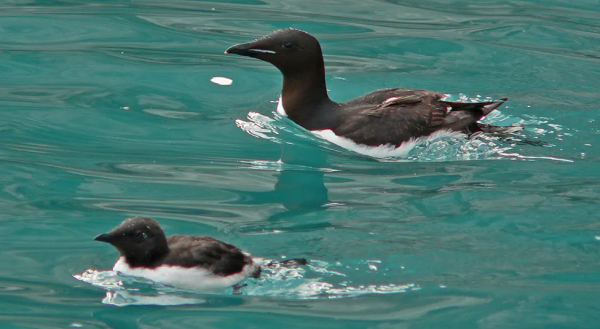
Adult male and young Thick-billed Murres migrate about 600 miles from nesting cliffs on Prince Leopold Island, located in the Canadian Arctic, to wintering areas off the southwest coast of Greenland (photo by Jean Iron).
|
About 3 weeks after hatching, a young Thick-billed Murre jumps from the high, narrow ledge crowded with nesting Thick-billed Murres. When the nestling makes the big leap to the ocean water below, the male takes over all interactions with it, leaving the adult female behind. Together the male and its pre-fledged hatchling undertake a remarkable swimming migration to their wintering range offshore from the southwest coast of Greenland, about 600 miles from the nesting cliffs on Prince Leopold Island, located in the high Arctic, north of the Canadian mainland.
As the time to leave the high ledge approaches, the adult male tries to synchronize its time at the nesting cliff to be on hand when the nestling jumps to the water below. Prime jumping time is usually between 4pm to 2am, coinciding with the period of lowest summer light from late afternoon into the night (the midnight sun doesn’t set in that region until August 11).
At the time the nestling jumps from the nest site, it has only grown to 1/4 of the adults’ size and its wings are poorly developed – it cannot fly, but it can swim. New waterproof plumage has replaced the fluffy down of nestlings, and the young murres are able to maintain their body temperature to survive in the cold Arctic water. Up to the time of leaving the nest, the adult pair shared the care and feeding of the lone nestling, divided time at the nest and away into approximate 12-hour shifts, with one adult searching up to 60 miles away for food, while the other adult brooded the nestling and protected it from predators.
But when the lone nestling makes the big leap to the ocean water below, the male takes over all interactions with its offspring, and under the cover of the low light of their first “night” in the water, adult males and pre-fledglings begin to band together and swim as far from the nesting colony as possible to evade aerial predators such as Glaucous Gulls. Ocean currents help the murres’ progress as they swim eastward in Lancaster Sound, then southeast across Baffin Bay. They have little more than a month to swim out of Lancaster Sound to avoid being trapped by ice.
For the first 5 to 6 weeks, the young murres cannot fly or find their own food; yet each one grows strong while being fed and led forward by the adult male. This incredible feat of long-distance migration by these very young birds takes place while they are still unable to fly and not yet fully developed – physically or behaviorally. For several weeks during the migration, the adult males also becomes flightless as they molt all of their flight feathers at once as part of their complete molt into winter plumage.
Thick-billed Murre researcher Anthony Gaston was asked why the female does not accompany the male and their young during this remarkable swimming migration, and he shared that the reason remains unknown. But Gaston added that a central theory is that the female puts more effort into feeding the nestling during the later stage of its growth on the nesting ledge and needs to rest.
The pressures of a brief Arctic nesting season, an unpredictable climate environment, and the tremendous energy involved for adults to feed their single nestling probably contribute to the short time that young murres remain on the nesting cliff before their big leap. But it could be a matter of timing too; the murres need to swim east then southeast before freeze-up. The young Thick-billed Murres remain at sea for the next 2 to 3 years before returning to Prince Leopold Island to begin their own nesting cycle.
The above information was provided by the American Birding Association in the article authored by Jean Iron at The Great Thick-billed Murre Swimming Migration - American Birding Association (aba.org)